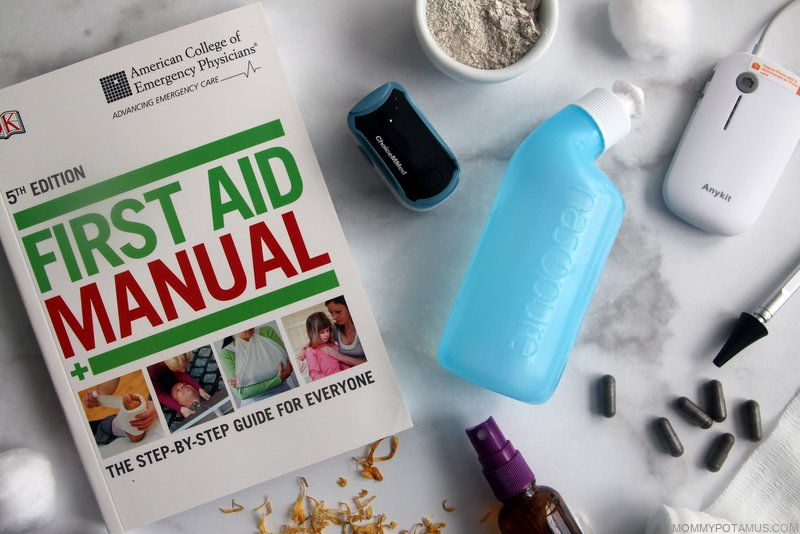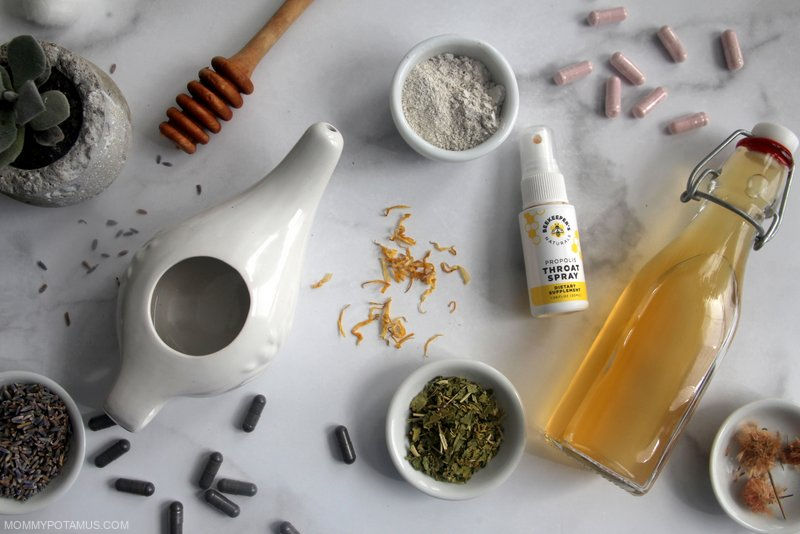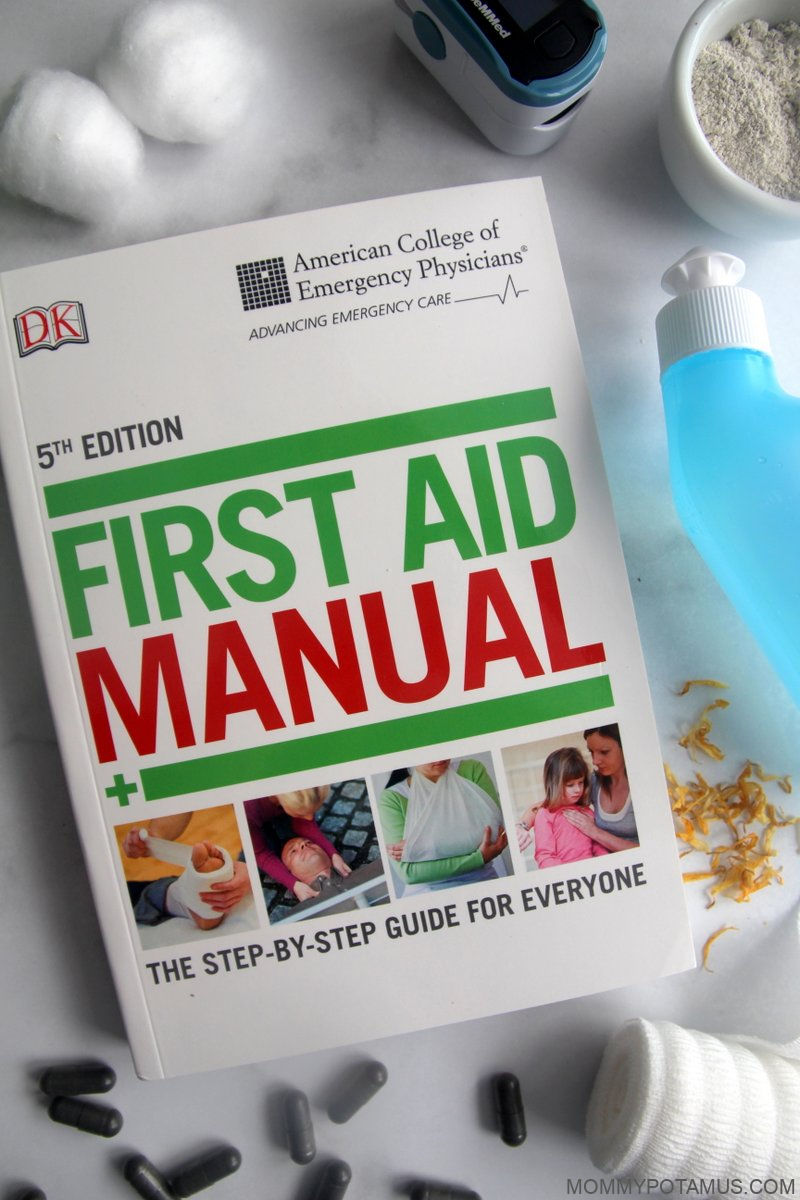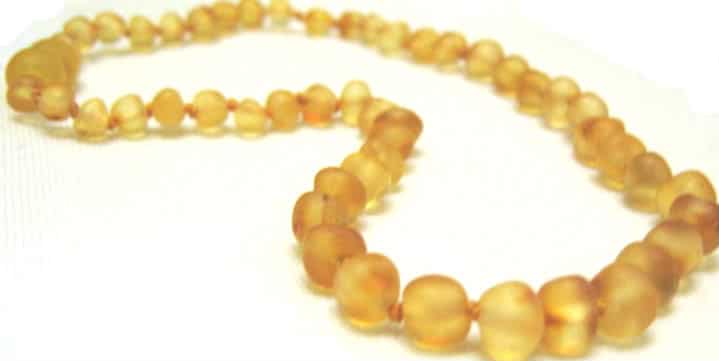
As a mom of three, I’ve cared for my littles through everything from bug bites to broken bones. When they’re sick or hurt, they immediately come to me with the expectation that I’ve got something in my home first aid kit + natural remedy stash to help them . . . and usually I do.
There have been times, though, when something came up and I realized I needed something that I didn’t have and couldn’t be picked up around the corner.
With that in mind, I thought I’d share the tools and supplies that I’ve found most helpful over the years.
Why Every Family Should Have A Home First Aid Kit
A well-stocked first aid kit + remedy stash is vital for responding effectively to common injuries and illnesses. I keep one kit in my home that I’ve customized to meet my family’s needs, and I also keep a basic pre-made kit in my car for emergencies.
I’ve used them for:
- Minor injuries or illnesses
- Stabilizing a more serious injury before taking my child in for medical care, such as using a triangular bandage to make a sling for a suspected broken collarbone and then immediately heading to the hospital for assessment and care
- Partnering with my family doctor to care for things at home under medical guidance. In the past year or so we all had what I shall call “the crud” and unfortunately it was during a time when getting an in-person doctor’s appointment was nearly impossible. Instead, I met with my functional medicine M.D. over video chat and implemented his recommendations at home. His approach included supportive supplements, which I had stocked in my remedy stash.
Though usually I am comfortable addressing situations at home, as I’ve mentioned there are also times when I absolutely reach out to our family doctor for input on a situation. I recommend that you do too if you’re not sure how to proceed. As always, this is not medical advice and none of these statements have been evaluated by the FDA.
My Home First Aid Kit Essentials
In addition to the basic first aid supplies and home remedy ingredients I’ll cover below, there are a couple of tools I’ve found to be very helpful:
Otoscope With Camera
When kids have earaches, home remedies like garlic and mullein oil can be very soothing. However, it’s important to make sure the eardrum is intact before using any kind of drops, which is why years ago I invested in this Dr. Mom Otoscope.
Developed by an ER doctor, it comes with a series of photographs that show what a perforated eardrum, ear infection, eardrum with tubes, and normal eardrum look like.
The downside of the Dr. Mom Otoscope is that you can’t show your doctor what you’re seeing. That’s why I eventually switched to this high definition otoscope with a camera. It connects to your phone, can take pictures, and is super easy to use.
Some reviewers have pointed out that the app needed to use it asks for unnecessary personal data which concerned me, so I downloaded it and then went to to my privacy settings to turn off permissions. I found that it wasn’t requesting all the info reviewers were saying, but I did turn off everything except for access to photos so that it can store pictures.
If you’d rather not use an app but do want to be able to take pictures to send to your care provider, this otoscope with camera is app-free.
Pulse Oximeter
This year when my family had some respiratory stuff going on, my doctor asked that I monitor our oxygen saturation levels at home and keep him updated.
Pulse oximeters are non-invasive monitors that are placed on a fingertip to measure oxygen saturation levels and heart rate. There are some things to know about how to take accurate readings that the FDA covers here, but in general they’re very easy to use.
This pulse oximeter fits all finger sizes from four-year-olds to adults.
Basic First Aid Supplies
If you check the American Red Cross, CDC and other organizations, you’ll find first aid checklists that share a lot in common but have some differences as well. Here are the basics I keep in stock:
- First aid guide book – Having the right supplies on hand is obviously important, but so is knowing how to use them. I bought this first aid manual because its written by the American College of Emergency Physicians and is one of the highest rated in user reviews.
- First aid ointment – Some natural and organic options include:
- Medical grade manuka honey for minor burns, cuts and scrapes
- Nutrasporin is made with chelated silver oxide
- Bandages of assorted sizes (The ones I linked to are made with organic, compostable bamboo)
- Butterfly bandages and/or these emergency laceration closures
- Sterile gauze pads (Ideally in both 2 inch and 4 inch squares)
- Flexible sterile rolled gauze for difficult to bandage areas
- Elastic wrap bandages for wrist, ankle, knee and elbow sprains/injuries
- Triangular bandages with safety pins to support arm or shoulder injuries
- Adhesive tape to keep gauze in place
- Scissors to cut gauze and tape
- Alcohol wipes
- Cold packs
- Tweezers for removing small splinters, bee stingers, etc.
- 2 pairs of latex-free gloves for addressing open wounds
- Thermometer
- Hydrogen peroxide
- Homemade hand sanitizer or pre-made natural hand sanitizer
- Tourniquet (Here’s how to use one, and here’s how to make one)
- Finger splint
- Mylar emergency thermal blanket
- A small packet of aspirin. Although I opt for natural options whenever possible, this is one thing I keep on hand for family and friends. According to the Mayo Clinic, “Aspirin may be life-saving in an adult with chest pain. If you or someone else has new or unexplained chest pain or may be having a heart attack, call for emergency medical help immediately. Then chew a regular-strength aspirin. However, don’t take aspirin if you are allergic to aspirin, have bleeding problems or take another blood-thinning medication, or if your doctor previously told you not to do so. Never give aspirin to children.” (emphasis mine)

Holistic First Aid + Home Remedy Kit Additions
Depending on the time of year I rotate some of the things on this list. For example, during fall/winter I focus more on immune support, and in the summer I stock herbs that help relax muscles after long days of intense activity.
In general, though, here are the core essentials I’ve found most helpful:
Kids’ Honey Cough Syrup from Genexa – Made with organic honey that’s been infused with echinacea, elderberry and acerola cherry extract, this syrup is delicious, soothing, and great to have on hand. Created by two dads on a mission to offer alternatives medicines with dyes and preservatives, Genexa is available in many grocery stores, health food stores, and pharmacies, so if you’re reading this list and you need something right away, you can check availability here. (I’m a partner with them, just FYI.)
B. Immune Throat Spray – This soothing throat spray incorporates bee propolis, which has been found to contain 300+ beneficial compounds that support immune function, wound healing and more.
Neti Pot or Nasopure Bottle – Nasal irrigation is so helpful for easing symptoms related to seasonal allergies, colds and the flu. My kids resist aren’t a fan of traditional neti pots but think the Nasopure bottles are easy to use.
Propolis Nasal Spray – Also made with propolis that contains 300+ flavonoids, polyphenols and other antioxidants that support immune function and more, this spray is specially made to support nasal health.
Activated Charcoal – Sometimes called the Swiss Army Knife of natural living, activated charcoal has lots of uses, including absorbing toxins. It’s listed in the World Health Organization Model List of Essential Medicines, and many practitioners recommend it for a variety of situations including gas, tummy bugs, food poisoning, calming itchy bug bites or poison ivy, and more. (1) Click here to read more about it.
Dried Elderberries – Elderberries are renowned for their ability to support immune function, which is why they’re so often incorporated into home remedies and store-bought products. Dried elderberries are perfect for making elderberry tea, elderberry syrup and elderberry gummies.
Raw Apple Cider Vinegar – For easing indigestion, heartburn, poison ivy, and sunburn plus other things like reducing dandruff and making homemade cough syrup, facial toner, and DIY hair detangler.
Marshmallow Root or Slippery Elm – Before it was used to make campfire treats, marshmallow root was traditionally boiled to soothe sore throats, upset stomachs and minor skin irritations. It contains a polysaccharide which “provides a protective, soothing coating to mucosa,” which is probably why its Greek name althea literally means “to heal.” (2) Here’s how to make it into a tea or infusion.
Like marshmallow root, the mucilaginous (gel-like) properties of slippery elm are very helpful for coating and soothing irritated throat mucosa. I used a powdered form to make homemade cough drops.
Herbal Teas for Recovery Support – Relaxation and restful sleep are so important to recovery after an injury or during an illness. I always keep calming herbs like chamomile, passionflower, valerian root, lemon balm or catnip on hand to support deep sleep.
Mullein Flowers – For making soothing garlic and mullein oil for earaches.
Salt Sock – A warm salt sock can be an incredibly soothing comfort measure for earaches. I first read about this remedy in a book by pediatrician Lillian Beard, M.D. – I admit I was skeptical, but it really did help my little one relax and get some much needed sleep.
Fire Cider – This traditional cold and flu support remedy is a spicy, sweet and tangy tonic that truly lives up to its name. It’s made with powerful immune-supporting, lymph moving, circulation stimulating, and digestion enhancing fresh herbs, roots and spices.
Yarrow – The ancients called it Herbe Militaris – the Military Herb – because it was often used to staunch bleeding and support wound healing. It’s good for so much more, though, including supporting the body during a fever, supporting digestion, easing forehead tension, and more. Click here to learn more about yarrow, including how to make yarrow tea.
Arnica Flowers – Arnica has been traditionally used by Swiss mountaineers to prevent muscle soreness, and according to The New York Times, “scientists have found good evidence that it works.” It can be made into an infused oil or cream to soothe sore muscles.
Witch Hazel – For soothing minor cuts and making after sun spray.
Aloe Vera Gel – For soothing minor burns and skin irritations (and making hair gel, too).
Vitamin C – According to this study, vitamin C supports “various cellular functions of both the innate and adaptive immune system. Our bodies don’t make vitamin C, so the only way to optimize levels is through dietary intake. I prefer to use whole food vitamin C over isolated forms: this acerola powder and these capsules are two of my favorite options.
Dried Oyster Capsules – It’s no secret that I’m a huge fan of whole-food based supplements that contain cofactors that increase bioavailability. Zinc is so important for supporting immune function, wound healing, carbohydrate metabolism and more, and oysters are an the richest natural source of it along with vitamin B12 and selenium.
Organic Honey – For making homemade cough syrup or elderberry syrup, reducing dandruff and more. If you’d rather not DIY, this cough syrup is made with organic honey that has been infused with echinacea, elderberry and acerola cherry extract.
Hot Water Bottle and/or Heating Pad – For soothing tummy and muscle aches.
Senna Laxative – Sometimes travel or other things can lead to constipation, especially in kids. For occasional use this senna laxative be really helpful, and it’s flavored with safe ingredients like organic caramel and vanilla to make it kid-friendly. There’s an adult version available, too.
Epsom Salt or Magnesium Chloride – For relaxing sore muscles and easing the symptoms of growing pains.
Electrolyte Solution – In case of dehydration, I keep the ingredients for this basic electrolyte drink recipe on hand.
Essential Oils – For making homemade vapor rub, aromatherapy inhalers, bug bite balm, and more.
Bentonite Clay – For making diaper rash cream (it works really well for other rashes, too)
Calendula Flowers – For making all-purpose healing salve. If fresh plantain or dandelion flowers are available I’ll sometimes make plantain salve or dandelion salve instead.
Dried Stinging Nettle – For making an herbal infusion that supports seasonal allergy relief, detox, bone healing, antioxidant support, energy support and more.
Optional Additions
Pain Reliever With Clean Ingredients – When one of my kids had minor surgery a couple of years ago we were told he’d need prescription pain medication. I called a compounding pharmacy and had the medication made for him without dyes, but I also bought Genexa’s over-the-counter liquid pain reliever.
It’s made with the same active ingredient in children’s Tylenol (acetaminophen), but without dyes and artificial inactive ingredients. The pain reliever worked beautifully and we never ended up using the prescription. There are now a few additional options available, including a chewable for kids and capsules for adults.
NoseFrida Baby Nasal Aspirator – For clearing stuffy noses.
Emergency Items
- Emergency phone numbers, including contact info for your family doctor and/or pediatrician and Poison Control, which in the United States is 800-222-1222
- Medical history info for each family member
- Medical release forms – This is a “legal way to outline your parental wishes and transfer decision-making authority to your child’s other caregivers when you are unavailable.” You can read more about them here.
Tips
Set a calendar reminder to restock anything used from your kit and check expiration dates on things like hydrogen peroxide. We don’t use ours often so I check mine once a year.
Additional Resources
You can see the Red Cross’ first aid checklist here. It’s very similar to mine with a few small exceptions.
For example, I don’t keep hydrocortisone cream on hand because I prefer to take a different approach with poison ivy rashes and other skin irritations, and I don’t currently have an emergency blanket because I live in a very warm climate.
Want more research-backed natural remedies?
No problem, I’ve created a free ebook for you – Kitchen Apothecary: 25+ Natural Remedies Using Ingredients From Your Pantry – as a gift for signing up for my newsletter. You’ll also get updates when I post about safe essential oils for pregnant/breastfeeding mamas, exclusive gifts and coupons (I was able to give away a jar of free coconut oil to anyone who wanted it recently!), plus other goodies.
Sign up using the form below.
1. Mayo Clinic. Charcoal, Activated (Oral Route)
2. Botanical Medicine For Women’s Health, Dr. Aviva Romm





